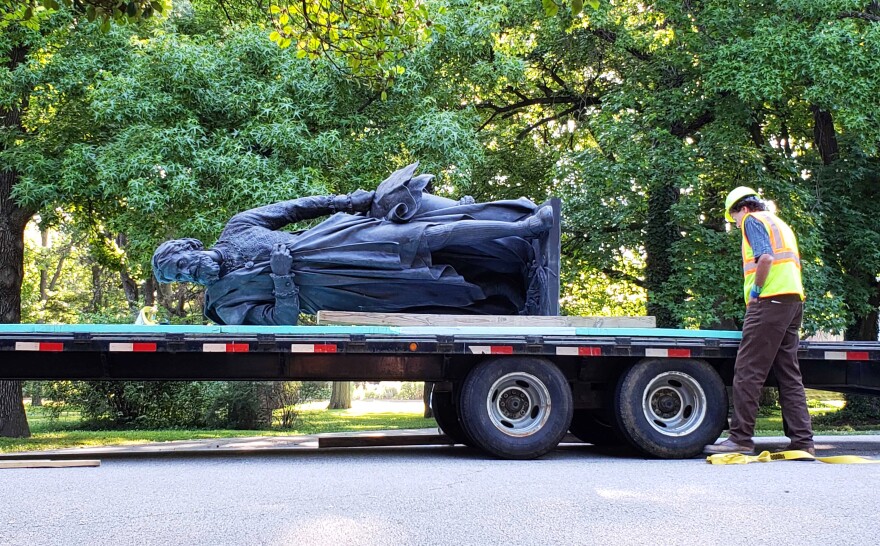The granite pedestal where a statue of Christopher Columbus once stood in St. Louis’ Tower Grove Park has remained empty for nearly four months.
A construction crew removed the bronze statue in June, at the behest of the park’s Board of Commissioners. Since then, community members have submitted ideas for future monuments honoring historically significant St. Louis residents, but officials say the park’s status as a National Historic Landmark complicates the process.
Petitioners and activists had called for the statue’s removal in 2018, citing the Italian explorer’s legacy of violence against Native Americans. After consulting with an advisory task force of residents and representatives from Native American tribes, park officials announced last September that they would install signs explaining the “historical context of Columbus.”
But following the killing of George Floyd by Minneapolis police in May, protesters nationwide began to topple statues of Confederate leaders and, in some cases, Christopher Columbus — prompting Tower Grove Park officials to reverse course.
“We were really concerned for the safety of the people in the park,” said Bill Reininger, executive director of Tower Grove Park, citing a Virginia protester who was critically injured by a falling Confederate statue.
In a statement announcing the removal, the park’s Board of Commissioners said the Columbus statue was originally meant to celebrate the contributions of immigrants in the neighborhood, but for many, it had come to symbolize a “historical disregard for indigenous peoples and cultures and destruction of their communities.”
On June 16, a small crowd cheered as a crane hoisted the statue in the air and laid it on a flatbed trailer, to be transported to an undisclosed storage location.
In the months since, St. Louis residents have taken to social media to debate possible replacements for the statue. One petition, organized by local performance artist Lindy Wormwood, calls for the statue to be replaced with a monument to Black artist Josephine Baker. It’s received 800 signatures.

The renowned performer, born in St. Louis in 1906, is a “symbol of racial unity,” Wormwood said. She decided to create the petition after seeing a post on social media from St. Louis performer Maxi Glamour.
“Josephine Baker had to overcome a lot of social obstacles to achieve her success,” Wormwood said. “Our country is ready to address racial issues that we’ve slept on for decades, if not centuries. And she was someone who, before her time, was ready to have those conversations.”
Still, the pedestal is likely to remain empty for the foreseeable future.
Tower Grove Park is one of seven parks in the U.S. designated as National Historic Landmarks — and every project has to be carefully reviewed to ensure it doesn’t jeopardize that status.
“Everything we do is very intentional, and sometimes it can take longer than what people want,” Reininger said. “Being a National Historic Landmark brings in tourism and allows us to apply for more grants. Having that significance gives us greater opportunity as well as more responsibility.”
Though they’re planning to cap the original base of the statue with a protective layer of granite, all other plans are on hold while the park’s Board of Commissioners waits for official guidance from the National Park Service.
The park is city-owned and receives roughly 40% of its funding from the City of St. Louis, but the original terms of the agreement with Henry Shaw, who donated the land for the public park, stipulate that it must be maintained and operated by an independent board.
While park officials and board members have no immediate plans to revamp the spot where Columbus once stood, Reininger said, the design process will be “very thoughtful” when it does begin.
Follow Shahla Farzan on Twitter: @shahlafarzan


